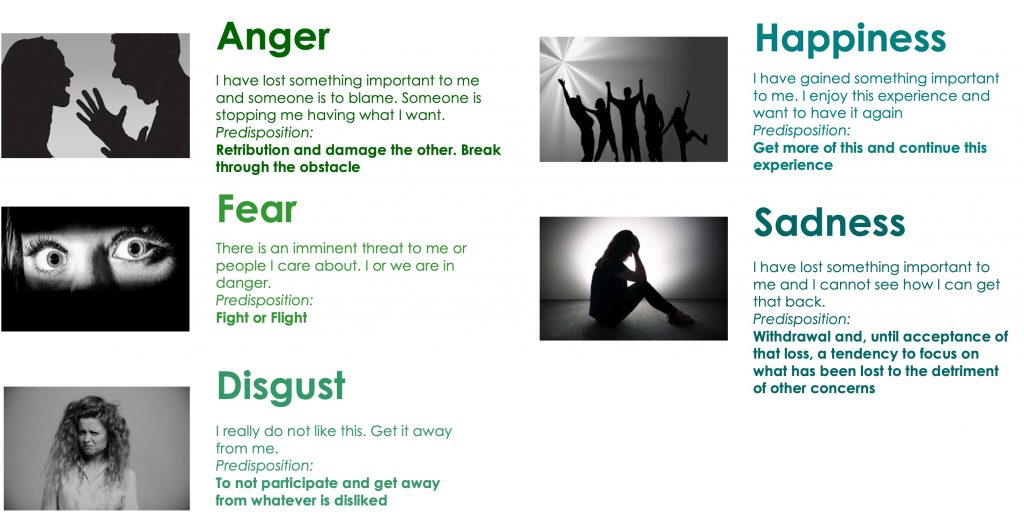
As they result from our habitual stances to the world and the resultant predictions and simulations, moods are constant through our lives and form the emotional feedback loops and interpretations from which we create our more immediate emotional experiences; defined as our emotions.
As with moods, emotions are our interpretation of affect generated by the interoceptive system as we manage our physical resources in response to our predictions and simulations. They provide a feedback loop for our current predictions. The key difference lies in the immediacy of the situation and rapid shift in body resources to deal with a breakdown or impending expected situation. In other words, emotions are directly tied to our prediction errors (breakdowns) in a situation and how our body reacts to them.
It is important to appreciate that various emotions relate to categories of experience and not a specific experience. For example, we can laugh in happiness, cry in happiness, or scream in happiness.
It is also important to recognise that we have learnt our emotional distinctions from others and that they are NOT universal. However, there has been a great deal of research into our emotional life and most researchers have defined FIVE fundamental emotions from which the western emotional palette is generated – fear, anger, disgust, sadness, and happiness.
However, remember these basic emotion categories are not universal, but a western construct.
For example, Utka Eskimos have no concept of anger. Tahitians have no concept of sadness. It seems that when Tahitians are in a situation where Westerners would expect to feel sad, Tahitians feel ill, troubled, fatigued, or unenthusiastic, all of which are covered by their broader term “pe’ape’a”.
How we distinguish our emotions and the emotions of others is critical to our social interactions. If we interpret that someone is angry, then we will deal with them in a certain way. The greater the granularity of our emotional distinctions and the better our guesses of others’ emotional states, the better we can interact with them. Here is a quick overview of five common emotions.

Anger
- Aggressive/Defensive approach to loss or injustice
- Unpleasant sensations with medium to high arousal
- “I have lost something important to me and someone is to blame. Someone is stopping me having what I want.”
- Indicators include focused energy and aggressive engagement
- Predisposition for retribution and to damage the responsible person. Break through the obstacle
- Variations: Irritation, Frustration, Rage, Annoyed, Indignant
Fear
- Defensive approach to immediate threat
- Unpleasant sensations with medium to high arousal
- “There is an imminent threat to me or people I care about. I or we are in danger.”
- Indicators include focused energy and engagement
- Predisposition to fight or flight
- Variations: Dread, Terror, Jealousy, Panic
Disgust
- Aggressive/Defensive approach to something strongly disliked
- Unpleasant sensations with medium to high arousal
- “I really do not like this. Get it away from me.”
- Indicators include closed posture and face and withdrawal
- Predisposition to not participate and get away from whatever is disliked
- Variations: Distaste, Revulsion
Happiness
- Constructive approach to something good or expanded possibilities
- Pleasant sensations with low to high arousal
- “I have gained something important to me. I enjoy this experience and want to have it again.”
- Indicators include energy and engagement, laughter, excitement
- Predisposition to get more of this and continue this experience
- Variations: Joy, Gratitude, Elation, Effervescence, Desire, Contentment, Bliss
Sadness
- Passive/Defensive approach to loss
- Unpleasant sensations with low to medium
- “I have lost something important to me and I cannot see how I can get that back.”
- Indicators include withdrawal, tears
- Predisposition to withdrawal and, until acceptance of that loss, a tendency to focus on what has been lost to the detriment of other concerns
- Variations: Grief, Helplessness, Melancholy, Misery, Morose, Regret
Clearly there are many emotion distinctions available to us should we seek them. Shame, Guilt, Love, Contempt, Confusion, Compassion, Boredom, Embarrassment, Awe, Envy, Jealousy, Fascination, Greed. The list goes on and on. Each one of them speaks to a physical experience and predispositions for action. Understanding and exploring our emotional life enriches our self-story.